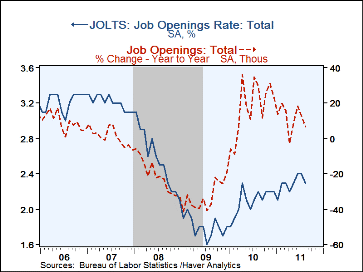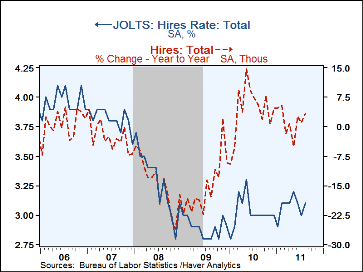 Global| Oct 12 2011
Global| Oct 12 2011U.S. JOLTS Rate Slips But The Number of Openings Falls Hard
by:Tom Moeller
|in:Economy in Brief
Summary
The Bureau of Labor Statistics reported in its Job Openings & Labor Turnover Survey (JOLTS) that the August job openings rate slipped m/m to 2.3%. The latest reading remained improved versus the recession low of 1.6%. The job openings [...]
 The Bureau of Labor Statistics reported in its Job Openings & Labor
Turnover Survey (JOLTS) that the August job openings rate slipped m/m
to 2.3%. The latest reading remained improved versus the recession low of
1.6%. The job openings rate is the number of job openings on the last
business day of the month as a percent of total employment plus job
openings. Falling hard, however, was the actual number of job
openings. They posted a 4.9% m/m drop (+6.8% y/y) to the lowest
level since May. The number of private sector openings fell 5.1% (+7.9%
y/y) while public sector openings fell 3.2% (-2.3% y/y).
The Bureau of Labor Statistics reported in its Job Openings & Labor
Turnover Survey (JOLTS) that the August job openings rate slipped m/m
to 2.3%. The latest reading remained improved versus the recession low of
1.6%. The job openings rate is the number of job openings on the last
business day of the month as a percent of total employment plus job
openings. Falling hard, however, was the actual number of job
openings. They posted a 4.9% m/m drop (+6.8% y/y) to the lowest
level since May. The number of private sector openings fell 5.1% (+7.9%
y/y) while public sector openings fell 3.2% (-2.3% y/y).
The private-sector job openings rate slipped m/m to 2.5% from a revised 2.6% but has been moving higher since the recovery began. Professional & business services job openings slipped m/m to 3.5%. That equaled last year's average and was up from the low of 2.1%. Openings in education & health services recently have been stable at 2.9%, as they have been in leisure hospitality at 2.5%. In manufacturing, openings held steady m/m at 2.0% and remained more-than-double the mid-2009 low. The job openings rate in government was more depressed at 1.3%.
The hires rate improved slightly to 3.1%, still near the lowest level since January. The hires rate is the number of hires during the month divided by employment. The hires rate in the private sector held m/m at 3.4% versus 3.5% during Q2. The government's depressed 1.2% rate was near where it's been since November. Overall, hires in the private sector rose 3.5% y/y. Hires in professional & business services were strongest with an 8.0% y/y rise. Education & health rose 1.9% y/y but hires in the factory sector fell 2.7% y/y.
The job separations rate has been stable recently at 3.0% but the actual number of separations fell 0.7% y/y. Separations include quits, layoffs, discharges, and other separations as well as retirements. The layoff & discharge rate alone held at 1.3%, just above the all-time low. The private sector layoff rate held at an elevated 1.4% but in the public sector it was 0.5%.
The JOLTS survey dates only to December 2000 and the figures are available in Haver's USECON database.
| JOLTS (Job Openings & Labor Turnover Survey) | Aug | Jul | Jun | Aug-10 | 2010 | 2009 | 2008 |
|---|---|---|---|---|---|---|---|
| Job Openings, Total | |||||||
| Rate(%) | 2.3 | 2.4 | 2.4 | 2.2 | 2.2 | 1.8 | 2.1 |
| Total(000s) | 3,056 | 3,213 | 3,169 | 2,862 | 2,921 | 2,376 | 2,938 |
| Hires, Total | |||||||
| Rate(%) | 3.1 | 3.0 | 3.1 | 3.0 | 36.3 | 34.7 | 39.3 |
| Total(000s) | 4,014 | 3,976 | 4,068 | 3,886 | 47,190 | 45,364 | 53,903 |
| Layoffs & Discharges, Total | |||||||
| Rate (%) | 1.3 | 1.3 | 1.4 | 1.4 | 16.4 | 20.0 | 17.6 |
| Total (000s) | 1,659 | 1,696 | 1,773 | 1,809 | 21,225 | 26,328 | 23,706 |
Tom Moeller
AuthorMore in Author Profile »Prior to joining Haver Analytics in 2000, Mr. Moeller worked as the Economist at Chancellor Capital Management from 1985 to 1999. There, he developed comprehensive economic forecasts and interpreted economic data for equity and fixed income portfolio managers. Also at Chancellor, Mr. Moeller worked as an equity analyst and was responsible for researching and rating companies in the economically sensitive automobile and housing industries for investment in Chancellor’s equity portfolio. Prior to joining Chancellor, Mr. Moeller was an Economist at Citibank from 1979 to 1984. He also analyzed pricing behavior in the metals industry for the Council on Wage and Price Stability in Washington, D.C. In 1999, Mr. Moeller received the award for most accurate forecast from the Forecasters' Club of New York. From 1990 to 1992 he was President of the New York Association for Business Economists. Mr. Moeller earned an M.B.A. in Finance from Fordham University, where he graduated in 1987. He holds a Bachelor of Arts in Economics from George Washington University.








